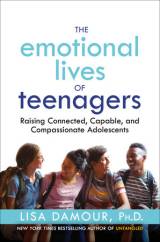Years ago, when I was still coaching high school cross country, a teenage girl skipped up to me after practice with a warning: Don’t count on her to race all the time. If her nerves got too intense before races, she might have to bow out in advance. “I have anxiety!” she explained with a nervous grin.
 I recalled this episode while reading psychologist and author Lisa Damour’s refreshing new book, “The Emotional Lives of Teenagers: Raising Connected, Capable, and Compassionate Adolescents.”
Damour’s voice is forceful but comforting, and she uses it here to
drive home her central point: Achieving mental health does not mean a
life without unhappiness, anguish, anger, worry or self-doubt. Rather,
these painful emotional states are an unavoidable feature of being
human, especially for young people buzzing with hormones and adjusting
to operatic moods prompted by recent rewiring of their brains. To best
help their developing teenagers, parents should work to build their
self-esteem and then guide them in learning how to express and manage
these feelings.
I recalled this episode while reading psychologist and author Lisa Damour’s refreshing new book, “The Emotional Lives of Teenagers: Raising Connected, Capable, and Compassionate Adolescents.”
Damour’s voice is forceful but comforting, and she uses it here to
drive home her central point: Achieving mental health does not mean a
life without unhappiness, anguish, anger, worry or self-doubt. Rather,
these painful emotional states are an unavoidable feature of being
human, especially for young people buzzing with hormones and adjusting
to operatic moods prompted by recent rewiring of their brains. To best
help their developing teenagers, parents should work to build their
self-esteem and then guide them in learning how to express and manage
these feelings.

Damour explains how we got to the point of considering unhappiness an aberration from some imaginary blissful norm. To start, advances in antidepressant medications made them safer and more attractive to the masses; she earnestly acknowledges that psychotropic medications improve and sometimes save lives. But prescriptions for Prozac and its medicinal brethren are as ubiquitous today as those for hypertension and cholesterol, making ordinary disappointment seem like a problem in need of a chemical solution. The mental wellness industry, too, worth about $131 billion globally, sells the idea that feeling rotten is avoidable (if you purchase just the right eucalyptus oil or bath bomb). Finally, because adolescents are in fact gloomier today than they were just ten years ago, it’s harder for parents and kids to figure out what distinguishes a legitimate mental health crisis from everyday emotional discomfort.
On this last point, Damour shares the findings of social psychologist Jonathan Haidt and psychology professor Jean Twenge who are sounding the alarm about youth mental health: Just before the start of the COVID-19 pandemic, 44 percent of teenagers reported experiencing anxiety, up from 34 percent about ten years ago; 37 percent felt “persistently sad or hopeless”; 16 percent of teenagers said that they’d developed a suicide plan. Those self-reported findings were matched by increases in hospitalizations for self-harm and a surge in the number of completed suicides, mostly since 2012. New findings released by the CDC in February revealed that girls and LGBTQ+ youth especially are floundering. Whether from what Haidt calls the rise in “phone-based childhoods,” creeping existential despair, or the effect of too little free and unstructured time — and likely some combination of all these and more — adolescents are struggling today in ways that they weren’t just a decade ago.
What’s a conscientious parent to do? “One of the most important things we can do for teenagers is help them distinguish between emotions that are uncomfortable (and) emotions that are unmanageable,” Damour told me.
Mothers and fathers should help their young children build authentic self-esteem by celebrating kids’ actions and avoiding effusive praise. Encourage girls and boys to be of service to others, not only to interrupt their solipsistic mindset, but also to reinforce their ability to make a difference. Next, urge them to develop an interest that’s unrelated to school or college applications, like cooking or knitting. Indulging an intrinsic interest is protective of kids’ feelings of self-worth. Finally, get going on these pursuits before a child reaches middle school, when even the healthiest child might falter.
The best thing parents can do after this is help their children learn both to express and regulate their emotions. Articulating painful feelings robs the feelings of their power, and learning how to manage them restores kids’ self-control.
To encourage open expression, listen, Damour advises. Be curious about your child’s state of mind. Ask your child to be as verbally precise as possible. Then, repeat back what your child says in her moment of sorrow or fear to demonstrate that you genuinely understand. Once they’ve expressed their heartache, try capturing their hurt in a one-sentence summary — like the editor who creates a headline for a story — and show empathy in return. “Listening attentively and then offering empathy shows them that they are doing exactly the right thing when they seek relief by finding a loving listener (that would be us!) and sharing what’s on their mind,” Damour writes. Above all, defy the temptation to jump in with creative solutions, as irresistible as that may seem.
For the teenager who resists face-to-face conversations, try other ways of inviting communication. Some children will respond to gentle text messages from parents. Others will be more talkative if they’re strapped into the back seat of the car, spared the awkwardness of direct eye contact. And if parents want their teenagers to talk, they might have to be around more often so that it can happen when the kids are conversational. Though they can be mercurial and ornery, teenagers typically like their parents and feel safer when they know where the grown-ups are. Another way to invite emotional expression: Own up to your own mistakes. For example, if you’ve gossiped to a friend about something personal your child has shared with you, and he learns of it, correct your blunder the right way: Apologize for violating his confidence, explain why you did, take responsibility, vow never to blab again, offer to make amends and ask for forgiveness. Because emotional expression is so essential to adolescents’ (and adults’) well-being, parents need to safeguard their kids’ trust.
After they’ve exhausted their efforts to spur expression, parents can help children learn to self-regulate. Suggest a distraction to interrupt unpleasant rumination. Offer them small comforts tailored to their preferences. Check in on their sleep habits and help them reclaim the eight to ten hours they need. When offering advice, tread lightly: Ask if it’s wanted and approach solutions jointly.
Some children experiencing protracted and irrational sadness and worry need more than a parent or guardian can provide. “I have so much empathy for parents who are trying to figure out if a meltdown is a sign of typical and expectable stress or a sign of a mental health concern,” Damour said. Adults would be wise to seek professional help if their adolescent’s feelings “don’t add up,” or they can’t manage them constructively, or they resort to risky coping strategies. But remember that zig-zagging, capacious feelings are not something to be avoided or feared. “Distress is part of life, and it certainly comes with the territory for teenagers,” she said.




